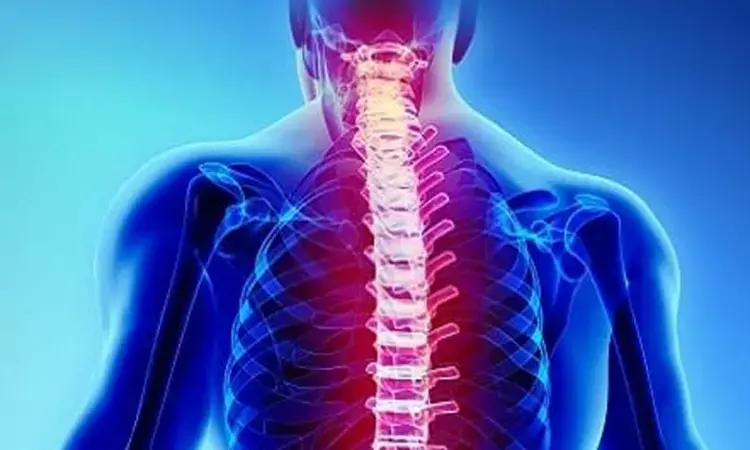- Home
- Medical news & Guidelines
- Anesthesiology
- Cardiology and CTVS
- Critical Care
- Dentistry
- Dermatology
- Diabetes and Endocrinology
- ENT
- Gastroenterology
- Medicine
- Nephrology
- Neurology
- Obstretics-Gynaecology
- Oncology
- Ophthalmology
- Orthopaedics
- Pediatrics-Neonatology
- Psychiatry
- Pulmonology
- Radiology
- Surgery
- Urology
- Laboratory Medicine
- Diet
- Nursing
- Paramedical
- Physiotherapy
- Health news
- Fact Check
- Bone Health Fact Check
- Brain Health Fact Check
- Cancer Related Fact Check
- Child Care Fact Check
- Dental and oral health fact check
- Diabetes and metabolic health fact check
- Diet and Nutrition Fact Check
- Eye and ENT Care Fact Check
- Fitness fact check
- Gut health fact check
- Heart health fact check
- Kidney health fact check
- Medical education fact check
- Men's health fact check
- Respiratory fact check
- Skin and hair care fact check
- Vaccine and Immunization fact check
- Women's health fact check
- AYUSH
- State News
- Andaman and Nicobar Islands
- Andhra Pradesh
- Arunachal Pradesh
- Assam
- Bihar
- Chandigarh
- Chattisgarh
- Dadra and Nagar Haveli
- Daman and Diu
- Delhi
- Goa
- Gujarat
- Haryana
- Himachal Pradesh
- Jammu & Kashmir
- Jharkhand
- Karnataka
- Kerala
- Ladakh
- Lakshadweep
- Madhya Pradesh
- Maharashtra
- Manipur
- Meghalaya
- Mizoram
- Nagaland
- Odisha
- Puducherry
- Punjab
- Rajasthan
- Sikkim
- Tamil Nadu
- Telangana
- Tripura
- Uttar Pradesh
- Uttrakhand
- West Bengal
- Medical Education
- Industry
Decompression alone may benefit patients with degenerative lumbar spondylolisthesis: NEJM

In patients with lumbar spinal stenosis and degenerative spondylolisthesis, it is uncertain whether decompression surgery alone is noninferior to decompression with instrumented fusion. In a recent trial conducted at the Orthopedic Department, Haukeland University Hospital, Oslo, USA involving patients who underwent surgery for degenerative lumbar spondylolisthesis, most of whom had symptoms for more than a year, decompression alone was noninferior to decompression with instrumented fusion over a period of 2 years.
The research is published in the New England Journal of Medicine.
Ivar M. Austevoll and associates conducted an open-label, multicenter, noninferiority trial involving patients with symptomatic lumbar stenosis that had not responded to conservative management and who had single-level spondylolisthesis of 3 mm or more.
Patients were randomly assigned in a 1:1 ratio to undergo decompression surgery (decompression-alone group) or decompression surgery with instrumented fusion (fusion group). the mean age of patients was approximately 66 years. The primary outcome was a reduction of at least 30% in the score on the Oswestry Disability Index (ODI; range, 0 to 100, with higher scores indicating more impairment) during the 2 years after surgery, with a noninferiority margin of −15 percentage points.
Secondary outcomes included the mean change in the ODI score as well as scores on the Zurich Claudication Questionnaire, leg and back pain, the duration of surgery and length of hospital stay, and reoperation within 2 years.
The study results showed that approximately 75% of the patients had leg pain for more than a year, and more than 80% had back pain for more than a year. The mean change from baseline to 2 years in the ODI score was −20.6 in the decompression-alone group and −21.3 in the fusion group (mean difference, 0.7; 95% confidence interval [CI], −2.8 to 4.3).
Also, in the modified intention-to-treat analysis, 95 of 133 patients (71.4%) in the decompression-alone group and 94 of 129 patients (72.9%) in the fusion group had a reduction of at least 30% in the ODI score, showing the noninferiority of decompression alone. In the per-protocol analysis, 80 of 106 patients (75.5%) and 83 of 110 patients (75.5%), respectively, had a reduction of at least 30% in the ODI, showing noninferiority.
The results for the secondary outcomes were generally in the same direction as those for the primary outcome. Successful fusion was achieved with certainty in 86 of 100 patients (86.0%) who had imaging available at 2 years. Reoperation was performed in 15 of 120 patients (12.5%) in the decompression-alone group and in 11 of 121 patients (9.1%) in the fusion group.
As a result, the authors concluded that decompression alone was noninferior to decompression with instrumented fusion over a period of 2 years.
DOI: 10.1056/NEJMoa2100990
Dr. Nandita Mohan is a practicing pediatric dentist with more than 5 years of clinical work experience. Along with this, she is equally interested in keeping herself up to date about the latest developments in the field of medicine and dentistry which is the driving force for her to be in association with Medical Dialogues. She also has her name attached with many publications; both national and international. She has pursued her BDS from Rajiv Gandhi University of Health Sciences, Bangalore and later went to enter her dream specialty (MDS) in the Department of Pedodontics and Preventive Dentistry from Pt. B.D. Sharma University of Health Sciences. Through all the years of experience, her core interest in learning something new has never stopped. She can be contacted at editorial@medicaldialogues.in. Contact no. 011-43720751
Dr Kamal Kant Kohli-MBBS, DTCD- a chest specialist with more than 30 years of practice and a flair for writing clinical articles, Dr Kamal Kant Kohli joined Medical Dialogues as a Chief Editor of Medical News. Besides writing articles, as an editor, he proofreads and verifies all the medical content published on Medical Dialogues including those coming from journals, studies,medical conferences,guidelines etc. Email: drkohli@medicaldialogues.in. Contact no. 011-43720751


